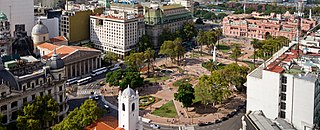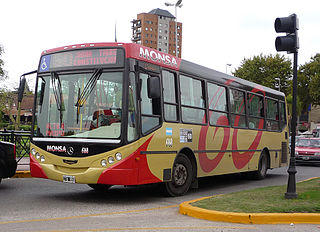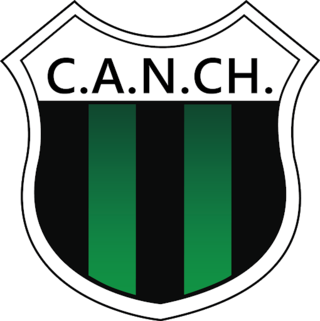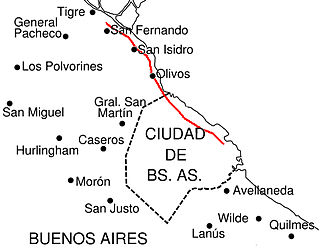
Buenos Aires is the capital city of Argentina, on the western shore of the Río de la Plata on South America's southeastern coast. "Buenos aires" is Spanish for "fair winds" or "good airs". Buenos Aires is classified as an Alpha− global city, according to the Globalization and World Cities Research Network (GaWC) 2024 ranking. The city proper has a population of 3.1 million and its urban area 16.7 million, making it the fourteen largest in the world.

Florida Street is a popular shopping street in Downtown Buenos Aires, Argentina. A pedestrian street since 1971, some stretches have been pedestrianized since 1913.

The Plaza de Mayo is a city square and the main foundational site of Buenos Aires, Argentina. It was formed in 1884 after the demolition of the Recova building, unifying the city's Plaza Mayor and Plaza de Armas, by that time known as Plaza de la Victoria and Plaza 25 de Mayo, respectively. The city centre of Buenos Aires, Plaza de Mayo has been the scene of the most momentous events in Argentine history, as well as the largest popular demonstrations in the country. On the occasion of the first anniversary of the May Revolution in 1811, the Pirámide de Mayo was inaugurated in the square's hub, becoming Buenos Aires' first national monument.

Route 60, known locally as El Sesenta, runs from Constitución station, in the centre of the city of Buenos Aires, Argentina to the Tigre Club in the partido of Tigre. The service is operated by Micro Ómnibus Norte S.A. (MONSA). Since November 1980, it has also managed the routes of the defunct bus route 38, which are currently provided under the number and colours of bus route 60, being distinguishable from the rest of the line only by the route indicator.

The Hipódromo de San Isidro is a horse racing track located in San Isidro, Buenos Aires, Argentina, owned by the Argentine Jockey Club. It is one of the largest and most important racetracks in the Americas. 120 racing days are held per year, on every Wednesday, every other Friday and Saturday, and some Sundays.

The Club Atlético de San Isidro is an Argentine sports club based in the city of San Isidro in Greater Buenos Aires. Originally established as a football club, San Isidro has gained recognition for its rugby union team, holding a record of 33 Torneo de la URBA championships. The senior squad currently competes at Top 12, the top division of the Unión de Rugby de Buenos Aires league system.

The practice of sports in Argentina is varied due to the population's diverse European origins and the mostly mild climate. Association football is the most popular discipline and other sports played both professionally and recreatively athletics, auto racing, basketball, boxing, cycling, field hockey, fishing, golf, handball, mountaineering, mountain biking, padel tennis, polo, roller hockey, rowing, rugby union, sailing, skiing, swimming, tennis, and volleyball. Argentine achievements can be found in team sports such as association football, basketball, field hockey and rugby union, and individual sports such as boxing, golf, tennis and rowing. Pato, the national sport, is not very popular.

Club Atlético Nueva Chicago is an Argentine sports club based in Mataderos, a neighborhood in the west side of Buenos Aires, formerly called "Nueva Chicago". The club's nickname, El Torito is an allusion to legendary 1930s boxer Justo Suárez, known as El Torito de Mataderos.

The following is an alphabetical list of topics related to the Argentina.

The 1951 Pan American Games, officially known as I Pan American Games and commonly known as Buenos Aires 1951, were held in Buenos Aires, Argentina between February 25 and March 9, 1951. The Pan American Games' origins were at the Games of the X Olympiad in Los Angeles, United States, where officials representing the National Olympic Committees of the Americas discussed the staging of an Olympic-style regional athletic competition for the athletes of the Americas.

English Argentines are citizens of Argentina or the children of Argentine citizens brought up in Argentina, who can claim ancestry originating in England. The English settlement in Argentina, took place in the period after Argentina's independence from Spain through the 19th century. Unlike many other waves of immigration to Argentina, English immigrants were not usually leaving England because of poverty or persecution, but went to Argentina as industrialists and major landowners.

On 16 June 1955, 30 aircraft from the Argentine Navy and Air Force bombed and strafed Plaza de Mayo, the main square of the Argentine capital Buenos Aires. The attack targeted the adjacent Casa Rosada, the seat of government, while a large crowd demonstrated in support of the president, Juan Perón. The strike took place during a day of official public demonstrations to condemn the burning of a national flag allegedly carried out by detractors of Perón during the recent Corpus Christi procession. The military reacted as a result of growing tension between Perón and his actions against the Roman Catholic Church. The action was to be the first step in an eventually aborted coup d'état. The number of identified bodies was put at 308, including six children, making it the deadliest terrorist attack in Argentine history. Some victims could not be identified.

Hurlingham Club is an Argentine sports and social club located in the city of Hurlingham, Buenos Aires. It is named after the Hurlingham Club in London and was set up in 1888 by the local Anglo-Argentine community. The town of Hurlingham and Hurlingham Partido grew up around the club, taking its name.

Lomas Athletic Club is an Argentine sports club from the Lomas de Zamora district of Greater Buenos Aires. One of Argentina's oldest clubs still in existence, Lomas is one of the four institutions that founded the "River Plate Rugby Championship" in 1899, The rugby union team currently plays in Primera A, the second division of the URBA league system.
Club Universitario de Buenos Aires, commonly known for its acronym CUBA, is an Argentine sports club located in Buenos Aires. Universitario hosts a large variety of sports and activities, including aikido, mountaineering, basketball, boxing, scuba diving, fencing, skiing, football, gymnastics, artistic gymnastics, golf, field hockey, judo, swimming, yachting, paddle tennis, basque pelota, rugby union, squash, taekwondo, tennis, volleyball, windsurf and yoga.

Avenida del Libertador is one of the principal thoroughfares in Buenos Aires, Argentina, and in points north, extending 25 km (16 mi) from the Retiro District of Buenos Aires to the northern suburb of San Fernando.

The Copa de Competencia Jockey Club was an official Argentine football cup competition contested between 1907 and 1933. The winner of this Cup was allowed to play the Tie Cup against the Uruguayan champion of Copa de Competencia.
Flores Athletic Club was an Argentine sports club from Flores, Buenos Aires. The club was pioneer in the practise of some sports that would become popular in Argentina, such as football, cricket, rugby union, polo, and tennis.

Club Deportivo Ferrocarril General Mitre, or simply Ferrocarril Mitre, is an Argentine sports club located in the Miguelete district of General San Martín Partido, Greater Buenos Aires.



















